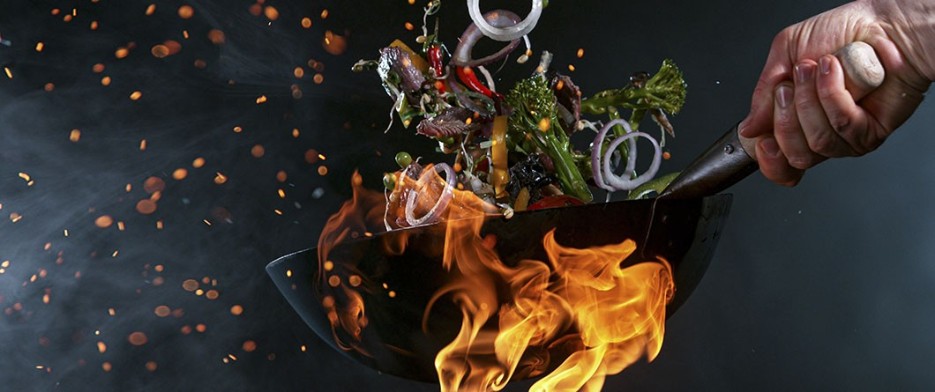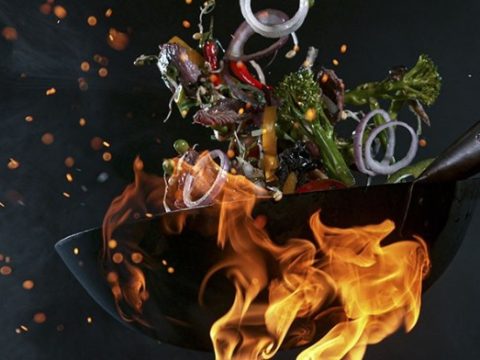When and How to Use a Wok
The wok has become a trusted ally in modern kitchens due to its versatility and efficiency. From authentic Asian recipes to quick and healthy dishes, this type of pan helps us cook with ease and flavor.
To achieve the best results, it is essential to use the right wok adapted to your needs and cooktop type.
What Is a Wok and Why Is It Special?
The wok originates from Asian cuisine and has been used for centuries for quick, high-temperature cooking.
It has a distinctive shape, with a rounded or flat bottom and high sides that allow constant stirring of ingredients without spilling them. This design promotes even heat distribution, and cooking with minimal oil preserves texture and flavor. Its versatility makes it ideal for frying, sautéing, steaming, or even smoking.
Reasons Why the Wok Is the Best
The wok is not only a symbol of Asian cuisine but also an extremely practical tool suitable for a variety of dishes. Thanks to its deep shape, which helps distribute heat evenly, the wok is ideal in several culinary situations:
1. Quick High-Heat Cooking
One of the most common times to use a wok is when you need to cook quickly without compromising taste or texture. High temperatures combined with constant stirring keep vegetables crisp and meat tender. With a wok, this process becomes more efficient, avoiding sticking and ensuring even cooking.
2. Frying with Reduced Oil
The wok’s deep shape allows shallow frying with minimal oil. For example, you can fry spring rolls, tofu, or shrimp without a deep fryer. The wok is made from materials that maintain constant temperature, which means less oil absorption and healthier food.
3. Steaming or Braising
The wok is not limited to frying. With a bamboo or metal steamer insert, it becomes an ideal steamer for Asian dumplings or vegetables. You can also use it for braising dishes that require gentle boiling and light stirring.
4. Cooking for Multiple People
Thanks to its generous size, the wok is perfect for cooking large portions. You can prepare Asian noodles, fried rice, or aromatic stews for the whole family.
5. Preserving Nutrients
Short cooking times and limited exposure to intense heat help preserve vitamins and minerals in vegetables and meat. This is another reason many nutritionists recommend using the wok for healthy cooking.
Of course, the best results come when using a high-quality wok, whether it has a nonstick coating or is made from carbon steel, which doesn’t interfere with food flavor.
How to Use a Wok Correctly (Step by Step)
Although it seems simple, the wok has its own “ritual.” By following a few essential steps, you’ll cook like a true Asian chef, whether preparing crisp vegetables, juicy meat, or a savory noodle dish.
Additionally, correct wok use extends its lifespan and guarantees excellent results.
1. Preheating the Wok – An Essential Step
Before adding any ingredient, the wok must be properly heated. This step prevents sticking and ensures quick, even cooking. Place the wok over high heat and let it heat for 1–2 minutes.
A wok reaches optimal temperature quickly and maintains constant heat without fluctuations.
2. Adding Oil and Aromatics
Once the wok is hot, add a small amount of high-smoke-point oil (such as peanut, sunflower, or sesame oil). Swirl the oil to coat the entire surface. Now you can add aromatics like garlic, ginger, or green onion to infuse the oil and create a flavorful base.
3. Cooking in Stages – Order Matters
To achieve the perfect texture, ingredients must be added in a specific order. Generally, start with meat or proteins (tofu, shrimp, etc.), followed by vegetables that require more cooking time (carrots, peppers), then tender vegetables (cabbage, spinach), and finally sauces or seasonings. This way, each ingredient is cooked properly without burning or becoming too soft.
4. The Stir-Fry Technique – Constant Movement
One of the basic principles of wok cooking is continuous movement. Use a wooden, silicone, or metal spatula to stir ingredients rapidly, lifting and dropping them in the wok. This technique ensures even cooking and prevents burning.
5. Avoid Overcrowding the Pan
Even if it’s tempting to cook everything at once, it’s important not to fill the wok completely. Too many ingredients lower the overall temperature and cause steaming instead of frying. If you have many ingredients, cook in batches.
With a little practice, you can turn any recipe into an authentic Asian delight.
6. Proper Cleaning After Each Use
After cooking, let the wok cool, then wash it with warm water and a soft sponge if needed. Dry immediately to prevent rust.
Common Mistakes to Avoid When Using a Wok
Although the wok is extremely versatile and efficient, incorrect use can compromise your dishes. It’s important to know the most common mistakes to avoid and fully benefit from the wok’s advantages.
1. Cooking at Too Low a Temperature
The wok is designed for high heat. Low temperatures make ingredients soggy and cause flavor loss. You also miss out on the caramelization essential for authentic Asian taste.
Tip: Preheat the wok and use high heat. A quality wok withstands high temperatures without damage or toxic emissions, especially if made of carbon steel or cast iron.
2. Using the Wrong Utensils
Many people use metal utensils that scratch the wok’s surface, especially if it’s nonstick. Over time, this degrades the wok and its nonstick properties.
Recommendation: Use wooden, bamboo, or silicone utensils.
3. Adding Oil to a Cold Wok
Adding oil to a cold wok and heating both together risks burning the oil before the wok is hot enough. This harms flavor and texture.
Correct Method: Heat the wok first, then add oil.
4. Using the Wrong Wok for Your Cooktop
Not all woks are compatible with every cooktop. For example, a round-bottom wok won’t work properly on induction without an adapter. Choosing the wrong wok leads to uneven heating or even cooktop damage.
Therefore, the best wok is one that fits your heat source—gas, electric, or induction. Choose flat-bottom, magnetic woks for induction or traditional round woks for open flame cooking.
Types of Woks – Advantages and Disadvantages
When you enjoy cooking with dedication, you want your tools to match your expectations. The wok is one of those essential pieces that sparks culinary experimentation and Asian-inspired recipes. It comes in several varieties, each with its own characteristics, pros, and cons.
1. Carbon Steel Wok – Intense, Quick Cooking
This is the most traditional wok, popular in authentic Asian kitchens. It’s used over very high flames with rapid movements, just like street-food chefs. However, to unlock carbon steel’s full potential, proper seasoning is required.
Advantages:
- Heats up quickly—ideal for stir-fry;
- Develops a natural nonstick patina over time;
- Lightweight.
Disadvantages:
- Requires initial “burn-in” over high flame until fully darkened;
- Needs frequent oiling to prevent rust;
- Home stovetops often lack the high flame intensity needed for peak performance.
Use it when you want authentic flavor, but expect to maintain it as part of the cooking ritual.
2. Stainless Steel Wok – Precision and Elegance
The stainless steel wok is a modern choice—durable and aesthetically pleasing. But it requires a special technique: heat the wok well, then add a small amount of cold oil and swirl it to create a protective layer before adding ingredients and cooking oil.
Advantages:
- Very durable and scratch-resistant;
- Nonreactive—won’t retain odors or flavors;
- Dishwasher-safe.
Disadvantages:
- Food sticks if not preheated and oiled correctly;
- Heats slower than carbon steel;
- Heavier.
Ideal for cooks seeking control and refinement but requiring careful adherence to cooking steps.
3. Nonstick Wok (Teflon or Ceramic)
This wok is perfect for easy use and minimal maintenance. It requires gentle cooking at medium temperatures to protect the coating.
Advantages:
- Beginner-friendly—food won’t stick;
- Easy to clean, no special techniques required;
- Great for healthy, low-oil cooking.
Disadvantages:
- Cannot tolerate very high heat;
- Coating degrades over time;
- Not suited for intense stir-fry or flambé.
Best for everyday, quick cooking—but handle with care.
4. Cast Iron Wok – Flavorful Slow Cooking
This wok is ideal for slow, flavor-infused dishes. Cast iron retains heat excellently but also requires regular seasoning to prevent rust.
Advantages:
- Even heat distribution and retention;
- Perfect for slow cooking or recipes with liquid;
- Oven-safe.
Disadvantages:
- Very heavy;
- Needs constant maintenance to avoid rust;
- Slower to heat.
This is our go-to wok when preparing special, patient dishes.
How to Choose the Best Wok for Your Needs
Choosing the right wok can mean the difference between a successful culinary experience and a frustrating one. Consider material, size, cooktop compatibility, and handling comfort:
- Material: Carbon steel for authentic stir-fry; cast iron for slow cooking; nonstick for ease of use.
- Size: 30–35 cm works well for 3–4 people.
- Cooktop: Flat bottom with magnetic base for induction; round bottom for gas.
- Handling: Balanced weight, secure handles, stable design.
Investing in a quality wok turns cooking into daily pleasure and guarantees impressive results every time.


